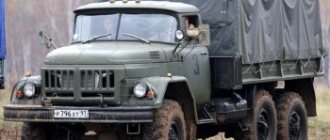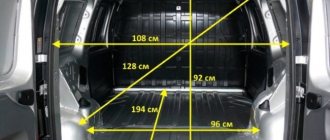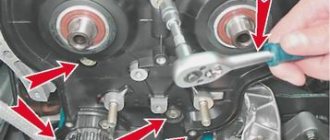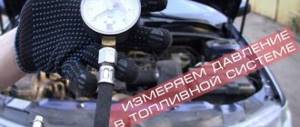GAZ-3307 Photo Video Characteristics Load capacity
GAZ-3307, 4.5-ton truck on the GAZ-53-12 chassis. The first copy was assembled at GAZ in 1989. The car body is a wooden platform with three folding sides - side and rear. On the longitudinal sides it is possible to install hinged transverse benches, extension sides, arcs and an awning. The double cabin is located behind the engine. Compared to the base model GAZ-53-12, the cabin is more comfortable, visibility is improved, as well as thermal and noise insulation.
GAZ-3307
- Car make: GAZ
- Country of origin: USSR
- Year of manufacture: 1989
- Body type: Truck
GAZ-3307 is a domestic 4th generation truck, the production of which is responsible for the Gorky Automobile Plant. The production of an onboard truck with a carburetor power unit started in 1989. Major production of the car was almost completely stopped in 1994. The truck that year was replaced by a new model GAZ-3309.
However, at this time the company did not completely stop producing the car, leaving specialized cars for government agencies in production. The plant continues to sell the version with a carburetor engine to the Belarusian market today. The car replaced the GAZ-53, which was already obsolete by the 1990s. It was necessary to improve the technical component and make the appearance more fresh. The entire GAZ model range.
GAZ-3307 - video of off-road driving
The sprung main seat is adjustable for driver weight, length, cushion and backrest angle. Many modifications of the GAZ-3307 are offered: GAZ 330701 - for cold climates; GAZ-33073 - cargo-passenger taxi; GAZ-33075 and GAZ-33076 are gas-cylinder vehicles running on liquefied petroleum gas (propane-butane) and compressed natural gas; GAZ-33072 - chassis for dump trucks; GAZ-33074 - chassis for buses; GAZ-3307 - chassis for specialized vehicles. Modifications of GAZ-330706 (for countries with temperate climates) and GAZ-330707 (for countries with tropical climates) are exported.
The car is equipped with a petrol V-shaped 8-cylinder engine with a capacity of 120 hp. s., running on A-76 gasoline. The GAZ-3307 is equipped with a single-plate clutch with peripheral springs and a hydraulic drive; four-speed gearbox; disc wheels; dependent front suspension on semi-elliptic springs with shock absorbers; rear suspension on semi-elliptic springs with additional springs; brake system with drum mechanisms, dual-circuit hydraulic drive (separate along the axes) and a hydraulic vacuum booster. In 1992, a batch of GAZ-3307 was produced, equipped with Japanese Hino diesel engines with a power of 136 hp. With.
Specifications
Technical characteristics of the GAZ-3307 dump truck:
| Characteristics | Indicators | Unit measurements |
| engine's type | ZMZ-511.10 | |
| Travel speed (maximum) | 90 | km/h |
| Load capacity | 4,5 | T |
| Engine power (nominal) | 92 | kW |
| Rotation frequency | 3200 | rpm |
| Number of engine cylinders | 8 | PC. |
| Cylinder diameter | 9,2 | cm |
| Piston stroke | 8 | cm |
| Working volume | 4,25 | l |
| Fuel tank volume | 105 | l |
| Fuel consumption per 100 km (speed 60 km/h) | 19,6 | l |
| Fuel consumption per 100 km (speed 80 km/h) | 26,4 | l |
| Front track size | 1,7 | m |
| Rear track size | 1,56 | m |
| Wheelbase | 3,77 | m |
| Clearance under the rear axle | 0,265 | m |
| Clearance under the front beam | 0,347 | m |
| Braking distance (speed 60 km/h) | 36,7 | m |
| Weight (total) | 7,85 | T |
| Weight (curb) | 3,2 | T |
| Width | 2,33 | m |
| Cabin height | 2,35 | m |
| Length | 6,33 | m |
| Body type | unloadable on 3 sides | |
| Body dimensions inside (length, height, width) | 3.52x0.52x2.28 | m |
| Body volume (standard sides) | 5 | m3 |
| Body volume (extension sides) | 10 | m3 |
| Underbody area | 8 | m2 |
Video review of the GAZ-3307 dump truck:
______________________________________________________________________________
Truck GAZ-3307 and its characteristics
The GAZ-3307 truck is designed for use on all types of paved roads and is characterized by high technical and operational parameters. When developing the design of this model, the unification of a wide range of spare parts and assemblies for existing vehicles was provided for, which facilitated maintenance and repair. The GAZ-3307 car with a carrying capacity of 4.5 tons has an all-metal double hood cab with panoramic glass, equipped with an effective ventilation and heating system. The cabin has a convenient placement of controls, a modern instrument panel, soft upholstery of doors and interior panels, adjustable seats equipped with seat belts. The platform has a wood-metal base and three folding sides; it is possible to install extension sides and an awning. The gearbox of the GAZ-3307 truck is 4-speed, the spring suspension is dependent. The service brake system with drum brake mechanisms is equipped with a hydraulic drive. It has two brake circuits, one of which is a spare brake. The steering uses a globoid worm mechanism with a three-ridge roller. The electrical equipment consists of a single-wire system with a mains voltage of 12 volts. Basic characteristics of the GAZ-3307 vehicle Load capacity, kg - 4500 Gross vehicle weight, kg - 7850 Vehicle curb weight, kg - 3200 Overall dimensions of the GAZ-3307 vehicle (mm) length - 6330 width - 2700 height - 2350 height (on the awning no load) - 2905
Wheelbase — 3770 Front wheel track — 1630 Rear wheel track — 1690 Ground clearance — 265 Turning radius, m — 8 Maximum speed with full load, km/h — 90 Maximum climbing angle, % (degrees) — 25 (14) Loading height of the platform, mm - 1365 Engine parameters of the GAZ-3307 truck Model - ZMZ-513 Type - Gasoline, 4-stroke, carburetor, liquid cooling Number and arrangement of cylinders - 8, V-shaped Cylinder operating order - 1-5-4 -2-6-3-7-8 Direction of rotation of the crankshaft - Right Cylinder diameter and piston stroke, mm - 92x88
Displacement, l — 4.67 Compression ratio — 7.6 Rated net power, kW (hp), no less — 87.5(119) Maximum net torque, Nm (kg/cm) — 413(42 ) Ventilation system - Closed Transmission GAZ-3307 Clutch - Single-disc, dry, friction, with a torsional vibration damper on the driven disk, with peripheral pressure springs. Clutch drive - hydraulic
Transmission — Mechanical, 4-speed Cardan transmission — Two open-type shafts with an intermediate support, three cardan joints on needle bearings
Main gear - Conical, hypoid type Differential - Conical, gear Axle shafts - Fully unloaded Chassis GAZ-3307 Frame - Stamped, riveted Wheels - Disc, with rim 152B-508 (6.0B 20) with a split bead ring Tires - Pneumatic, radial , size 8.25 R20(240R508)
Springs - Four, longitudinal, semi-elliptical with additional springs in the rear suspension. Shock absorbers - Hydraulic, telescopic, double-acting. Installed on the front axle of the car Steering and braking system GAZ-3307 Steering mechanism type - Globe worm with a three-ridge roller with gear ratio - 21.3 (in the middle position)
Service brake system - With pneumohydraulic drive. Brake mechanisms - shoe, drum type with automatic adjustment of the gap between the lining and the drum Spare brake system - Each circuit of the working brake system Parking brake system - With a mechanical cable drive to the rear wheel brake mechanisms Electrical equipment and instruments GAZ-3307 Wiring system - Single-wire, negative leads connected to the car body Rated voltage in the network, V - 12 Generator - AC, with built-in rectifier unit G287 Voltage regulator - 2702.3702 Rechargeable battery - One (6ST-75) or two (6ST-55A3 or 6ST-77AZ) Starter - ST230- A1 Basic parameters of adjustments of the GAZ-3307 car Clearances between valve stems and rocker arms on a cold engine, mm
— inlet — 0.20-0.30 (0.15-0.20) — exhaust — 0.20-0.30 (0.15-0.20)
Rated voltage of the generator, V - 14 Deflection of the fan and generator drive belts when pressed with a force of 4 daN (4 kgf), mm - 10-15 Free travel of the clutch pedal, mm - 40-55 Full travel of the clutch pedal, mm - 190-200 Free brake pedal travel, mm - 3-13
______________________________________________________________________________
______________________________________________________________________________
- Clutch GAZ-3308, 3309
- Dismantling the GAZ-3308, 3309 gearbox
- Drive axles GAZ-3308
- Transfer case and cardans GAZ-3308
- Cardans GAZ-3307, 3309
- Rear axle GAZ-3309, 3307
- Suspension GAZ-3309
- Steering GAZ-3309
______________________________________________________________________________
______________________________________________________________________________
- Clutch GAZ-53, 3307
- Gearbox GAZ-53, 66
- Rear axle GAZ-53
- Steering GAZ-53, 66
- Ignition installation GAZ-53
- Clutch GAZ-66
- Drive axles GAZ-66
- Brake system GAZ-66
- Winch and power take-off GAZ-66
- Operating systems of the GAZ-66, GAZ-3307 engine
- Engine ZMZ-402 Gazelle GAZ-2705
- Clutch Gazelle GAZ-2705
- Gazelle GAZ-2705 gearbox
- Front axle Gazelle GAZ-2705
- Cylinder head and camshaft Cummins ISF 2.8
- Fuel system of the Gazelle Cummins ISF 2.8 engine
- Cylinder block and piston group of the Cummins ISF 2.8 engine
- Crankshaft engine Cummins ISF 2.8 Gazelle
- Engine Cummins Valdai GAZ-33106
- Clutch and gearbox Valdai
- Bridges Valdai
- Steering Valdai
Catalogs of spare parts and assembly parts
History of creation
Soon after the creation of the third generation of GAZ trucks (models 52 and 53), work began on the development of promising models. The first developments appeared in the second half of the 60s and represented a modernized version of the existing machine. In 1972, the first running prototypes of GAZ-53-11 trucks appeared.
At the same time, ZIL began work on the future ZIL-4331, which was externally different from the old generation vehicles. Since there was constant rivalry between the GAZ and ZIL plants, the Gorky plant was forced to begin developing a new cabin. An additional incentive for the creation was the acquaintance with the German Magirus Deutz trucks, which began to be supplied to the USSR.
The project of the future GAZ-3307 truck received the designation 4301.
A special feature of the 4301 model was the engine - a 6-cylinder diesel GAZ-542, which developed up to 125 horsepower. The gasoline version, designated GAZ-3307, went through a test cycle by the end of 1986, and mass production began in 1989. The technical characteristics of the GAZ-3307 with the same power unit turned out to be higher than those of its predecessor.
The old model was gradually phased out by 1993. The diesel GAZ-4301 looked little different from its gasoline counterpart, but had a number of differences. Production was discontinued in 1995 after the assembly of just over 28 thousand cars.
The GAZ-3307 truck remained in production until 2009; small batches of vehicles were produced for several more years (about 500 trucks per year). The reason for discontinuation was the expansion of production of vehicles equipped with economical and powerful diesel engines. The latest gasoline GAZ-3307 complied with Euro-3 toxicity standards.
History of creation and design features of the model
Active work on creating a model of a new truck was started by the designers of the Gorky Automobile Plant in the early eighties. In order to reduce the cost of production and simplify the repair and maintenance of Gas 3307, their main components and assemblies were unified with the machines that had been coming off the production line for a long time. The new generation of cars got a different cabin. As for the carburetor engine and chassis, in fact, they were inherited from the previous series. The first copies were released at the end of 1989, and 4 years later they finally ousted the third generation of Gas trucks from the assembly line.
The new cars received a hood layout, and the cabin itself was taken from the experimental model released in 1984, with the index 4301. The modern Gas 3307 cabin, designed for two people, is quite spacious and comfortable. The driver's seat, unlike previous generations of trucks, can be adjusted in the horizontal plane, as well as change the angle of the backrest. Access to the main controls is not difficult, their placement is quite convenient. Ventilation and heating systems provide additional comfort.
In the line of GAZ trucks, this model is the first to have power steering installed. For cars of this series, released in the early 90s, the steering mechanism was a globoidal worm with a three-ridge roller, no different from that which was present on previous series of trucks. A little later, the mechanism was modified, which made it possible to reduce the effort on the steering wheel. On later versions of trucks, the steering mechanism is made according to the “screw-ball nut” principle.











